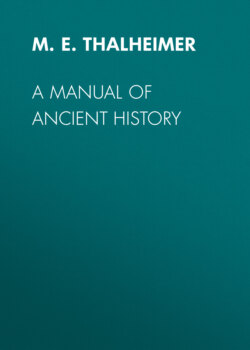Читать книгу A Manual of Ancient History - M. E. Thalheimer - Страница 8
CHALDÆAN MONARCHY.
Оглавление26. After the dispersion of other descendants of Noah from Babel,[5] Nimrod, grandson of Ham, remained near the scene of their discomfiture, and established a kingdom south of the Euphrates, at the head of the Persian Gulf. The unfinished tower was converted into a temple, other buildings sprang from the clay of the plain, and thus Nimrod became the founder of Babylon, though its grandeur and magnificent adornments date from a later period. Nimrod owed his supremacy to the personal strength and prowess which distinguished him as a “mighty hunter before the Lord.” In the early years after the Flood, it is probable that wild beasts multiplied so as to threaten the extinction of the human race, and the chief of men in the gratitude and allegiance of his fellows was he who reduced their numbers. Nimrod founded not only Babylon, but E´rech, or O´rchoë, Ac´cad, and Cal´neh. The Chaldæans continued to be notable builders; and vast structures of brick cemented with bitumen, each brick bearing the monarch’s or the architect’s name, still attest, though in ruins, their enterprise and skill. They manufactured, also, delicate fabrics of wool, and possessed the arts of working in metals and engraving on gems in very high perfection. Astronomy began to be studied in very early times, and the observations were carefully recorded. The name of Chaldæan became equivalent to that of seer or philosopher.
27. The names of fifteen or sixteen kings have been deciphered upon the earliest monuments of the country, but we possess no records of their reigns. It is sufficient to remember the dynasties, or royal families, which, according to Bero´sus,[6] ruled in Chaldæa from about two thousand years before Christ to the beginning of connected chronology.
1. A Chaldæan Dynasty, from about 2000 to 1543 BC The only known kings are Nimrod and Chedorlao´mer.
2. An Arabian Dynasty, from about 1543 to 1298 BC
3. A Dynasty of forty-five kings, probably Assyrian, from 1298 to 772 BC
4. The Reign of Pul, from 772 to 747 BC
During the first and last of these periods, the country was flourishing and free; during the second, it seems to have been subject to its neighbors in the south-west; and, during the third, it was absorbed into the great Assyrian Empire, as a tributary kingdom, if not merely as a province.
